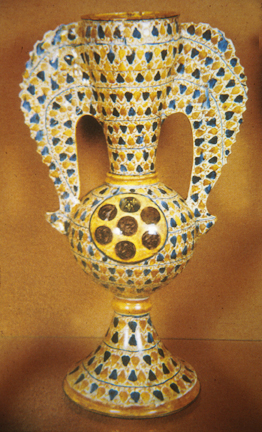The luster technique originated in Egypt in about 700 CE and was first used on blown glass, but it was not long before potters learned how to fume the metallic salts of gold and silver onto the surfaces of their work. It quickly spread to Persia, where potters came to specialize in luster ware in cities such as Kashan, and in neighboring Raqqa and Basra. Lusterware would become a hallmark of Islamic ceramics, and is one ceramic technique that did not originate in China. Vessels of gold and silver were also prohibited in the Islamic world , so the use of a lustered surface on ceramic became a beautiful substitute. The luster technique followed the spread of Islam across Northern Africa, and into Spain with the Moorish conquest. Luster is in a sense an overglaze process. First the pottery is fired with a glaze, in this case, an opaque, white glaze to cover the dark terra cotta clay, and provide a more 'porcelain' like surface. After that, the sulfates of metals such as gold, silver, copper, and bismuth are applied using an oil based medium onto the glaze fired surface. The actual luster firing is done a relatively low temperature (around 1300° F) to fuse the metallic film onto the glaze surface. As surface phenomena, lusters are somewhat impermanent and will abrade off with age and use. The colors will also fade over time with exposure to the sun.
This particular example, a wing-handled vase, thrown in several sections and assembled, has a vine and leaf decoration painted in cobalt blue. The yellow leaf areas are overglaze luster and would have originally been a much brighter gold. Such large (22"- 36" ht.), ornamental pieces were never meant to have any other function than to showcase the skill and craftsmanship of the potter, and not incidentally, the wealth and power of those who commissioned them. This vase was made in Manises, near Valencia on the eastern coast of Spain. Valencia was a center of lusterware production, and pieces were sent not only to other cities within al-Andalus, but were exported via Majorca into Italy as well. The central medallion here contains the coat-of-arms of the Medici family.

Winged Vase, Manises (Valencia) Spain 1465 CE


